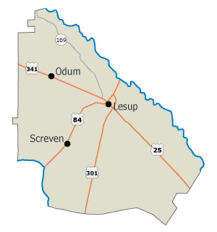
Georgia is the recipient of a $400,000 grant from the U.S. Department of Health and Human Services to be used for “reducing the morbidity and mortality of substance use disorder, including opioid use disorder, in rural communities.” Alabama received an identical grant.
The grant is part of the Rural Communities Opioid Response Program (RCORP) to expand Medication Assisted Treatment (MAT) in eligible hospitals, health clinics, or tribal organizations in high-risk rural communities. The concept is a ‘whole patient’ approach that requires that eligible entities provide and/or coordinate complementary services (e.g., provision of or referral to other SUD/OUD and mental health services, assistance with transportation, etc.).
“Recipients across 40 states will receive $200,000 for one year to formalize partnerships with local stakeholders, conduct needs assessments, and develop plans to implement and sustain substance use disorder (SUD), including opioid use disorder (OUD), prevention, treatment, and recovery interventions,” said the HRSA.
The recipients are as follows:
Georgia received two awards totaling $400,000 in funding.
| Grantee Organization | City | State | Award Amount |
|---|---|---|---|
| Corporation of Mercer University, The | Macon | GA | $200,000 |
| Wayne, County of | Jesup | GA | $200,000 |
The federal agency awarded $24 million for the second round of Rural Communities Opioid Response Program (RCORP) planning grants. Recipients across 40 states will receive $200,000 for one year to formalize partnerships with local stakeholders, conduct needs assessments, and develop plans to implement and sustain substance use disorder (SUD), including opioid use disorder (OUD), prevention, treatment, and recovery interventions.
You can see the full list of recipients across the nation here.
“Rural communities continue to face several challenges in accessing SUD/OUD prevention, treatment, and recovery services,” said Associate Administrator for the Federal Office of Rural Health Policy Tom Morris. “Over half of rural counties nationwide lack a provider who is waivered to prescribe buprenorphine, and on average, rural opioid users are more likely to be uninsured, less educated, and lower income than their urban counterparts.”
Jessica Szilagyi is a former Statewide Contributor for AllOnGeorgia.com.


Bulloch Public Safety
Several Arrested in Bulloch for Narcotics Trafficking After Citizen Complaints

Bulloch Public Safety
12/19/2025 Booking Report for Bulloch County

Chattooga Local News
Trump signs executive order reclassifing marijuana

Bulloch Public Safety
12/18/2025 Booking Report for Bulloch County

Bulloch Public Safety
11/24/2025 Booking Report for Bulloch County

Bulloch Public Safety
12/12/2025 Booking Report for Bulloch County

Bulloch Public Safety
12/01/2025 Booking Report for Bulloch County

Bulloch Public Safety
12/11/2025 Booking Report for Bulloch County

Bulloch Public Safety
12/16/2025 Booking Report for Bulloch County




